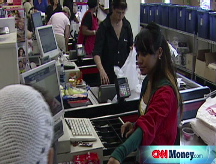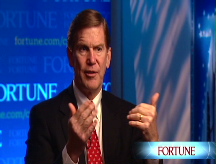Americans rein in online spending
Previously one of the fastest growing retail segments, study shows third-quarter e-commerce grew half as fast as in the prior quarter.
NEW YORK (CNNMoney.com) -- Growth in online spending in the U.S. slowed in the third quarter, according to a study released Friday, in yet another sign that the economic slowdown has caused the American consumers to pull back.
According to a study released by comScore (SCOR), a company that tracks online business, e-commerce grew by 6% in the third quarter versus the same quarter a year ago. But that was slower than the 13% year-over-year growth in the second quarter and 12% year-over-year increase in the first quarter.
"It really goes to the point that no segment has been immune" to the pull back in consumer spending, said Michael Niemira, chief economist and director of research at International Council of Shopping Centers. "Every segment of retail has been affected," he said.
Total online retail sales in the U.S. were approximately $30 billion in the third quarter, excluding travel spending, according to the study.
Online spending has been the fastest growing area of retail, but as the credit crunch has cramped the consumer, even e-commerce has fallen off significantly.
"Beginning in Jan. of 2008, we saw a fairly precipitous decline that coincided with some of the softness in the market," said Andrew Lipsman, senior analyst at comScore. The drop off in online retail sales "does coincide pretty closely with what has been going on in the market and consumer confidence," he said.
Looked at on a month-by-month basis, online spending grew by 18% in December of 2007 and 20% in November, compared with the same month a year prior. In June of 2007, online spending had surged 25% over the previous year.
Part of what contributed to the historical surge in Internet retail spending, according to Niemira, was the transfer of dollars from mail order catalogue spending to spending on the Web. In the short term, however, the decline in retail spending was due to to consumer pullback in the face of economic hard times.
Lipsman said that the deceleration of retail spending on the Internet happened too immediately to be a natural unwinding, according to Lipsman. "It is clear that this is not just a market reaching its point of maturation," said Lipsman.
"Consumers' economic pressures continue to have a significant impact on retail spending, which is evident in the slowing growth rates in the online channel," said comScore Chairman Gian Fulgoni in a written statement.
Fulgoni said that the online segment remained important, however, because consumers could be expected to comparison shop for bargains online heading into a tight holiday season.
Lipsman echoed the sentiment. "Consumers in this economy are going to shop around and online is the easiest way to do it. They are going to look for the best price," he said.
While consumers have pulled back their spending overall, video game sales surged by 60% in the third quarter of 2008 compared with a year earlier. Spending on furniture and appliances also jumped, up by 52% from the same quarter one year ago.
Consumers decreased their spending on music, movies and video, with sales down 29% from 2007 levels. And consumers spent 11% less on jewelry and watches.
"Discretionary purchases are one of the first things to see declines and a lot of the categories that we are seeing declines in here one might consider discretionary purchases," said Lipsman.
The surge in video games sales seems to contradict this trend, but Lipsman said that during the last holiday season, the surge in video game sales growth far outpaced current levels. In addition, the video game segment is a smaller section in terms of sales dollars, and so changes are more exaggerated.
In a survey of 1,000 consumers, ComScore said 82% are more afraid about the economic future than ever before. ![]()




